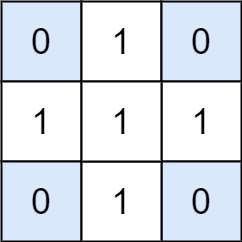1074. Number of Submatrices That Sum to Target
Description
Given a matrix and a target, return the number of non-empty submatrices that sum to target.
A submatrix x1, y1, x2, y2 is the set of all cells matrix[x][y] with x1 <= x <= x2 and y1 <= y <= y2.
Two submatrices (x1, y1, x2, y2) and (x1', y1', x2', y2') are different if they have some coordinate that is different: for example, if x1 != x1'.
Example 1:

Example 2:
Constraints:
1 <= matrix.length <= 1001 <= matrix[0].length <= 100-1000 <= matrix[i] <= 1000-10^8 <= target <= 10^8
Tags
Array, Dynamic Programming, Sliding Window
Solution
From LeetCode 560. Subarray Sum Equals K we know how to obtain the subarrays whose sum equal to a certain target value. This problem extends it to 2D scenario, but we can also take advantage of the solution of 1D version subarraySum(). We traverse all continuous rows permutations, and sum up these rows along each columns to obtain a 1D array. This array and target are the arguments of subarraySum(). The final result is the sum of all return values of this function.
Complexity
Time complexity:
Space complexity:
Code
Reference
Last updated
Was this helpful?